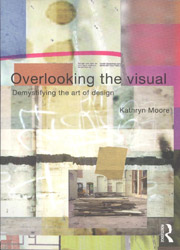Overlooking the Visual – demystifying the art of design
Pat Griffin, University of Ulster
Moore, K. (2010), Routledge. .......... Kathryn Moore is a landscape architect, lecturer and writer working within the field of design - theory, practice and education. Overlooking the Visual – demystifying the art of design was published in 2010. This is a great book, particularly for anyone teaching design practice and theory, and although Moore’s main focus is on landscape architecture, an...
 Author: Kathryn Moore
Author: Kathryn MoorePublisher: Routledge
Publication date: 2010
ISBN: 978-0-415-30870-0
Price: £25.99
Kathryn Moore is a landscape architect, lecturer and writer working within the field of design - theory, practice and education. Overlooking the Visual – demystifying the art of design was published in 2010. This is a great book, particularly for anyone teaching design practice and theory, and although Moore’s main focus is on landscape architecture, and she draws her many examples from this domain, it is still clear to see how her ideas can be easily transferred across disciplines. At its heart, this book is about challenging the traditional belief that the art of design is difficult to pin down, let alone articulate or pass on, and that developing a knowledge-based, ideas-led approach to teaching design will ultimately lead to better designers and better design. Moore insists that: ‘Demystifying the art of design represents the best chance we have of consistently achieving design excellence, which is the ability to create good-looking places, because the quality of our environment is directly proportional to the quality or our lives.’
Moore contextualises her argument by a critical examination of the prevailing rationalist position that emphasises binary modes of thinking, and of viewing the world - blinding us with the either/or dichotomy: art versus science, etc. She suggest that the ‘…crux of the problem is that an intractable rationalist paradigm dominates our thinking to such a degree we no longer give it much thought…’ This belief system largely remains unchallenged and is so entrenched within western culture that there is no, or little room, for discussion, debate or movement.
Theories of perception, Moore believes, have reinforced this dualistic approach putting forward a way of seeing which stresses the difference between the senses and intelligence, the emotional and the factual. Uprooting the idea of perception / of seeing from the realm of the metaphysical Moore replants it firmly into the material world. The issue is how to draw the ‘…connections between visual and verbal thinking, creativity and rationality, intuition and intelligence…’ Turning to the pragmatists, it appears that the fundamental mistake was to think in terms of difference. In offering an alternative pragmatist inspired approach, Moore aims to redefine the ‘…relationship between the senses and intelligence (which) means that essentially there is no need to choose one or the other’.
The book is structured into eight chapters, an introduction which addresses the key issues and articulates Moore’s ‘…passionate desire to improve design quality and a recognition that this can only happen through education…’ Chapter two, ‘The sensory interface and other myths and legends’examines the philosophical underpinnings of perception theories, challenges rationalist ideas and drawing from a pragmatist viewpoint Moore proposes a new relationship between the emotions and the intelligence. In Chapter three, ‘Teaching the unknowable’, Mooredefines an ‘artistic sensibility’ - identifying ‘artistic judgment’, ‘aesthetic expertise’ and ‘technological know-how’ as the fundamental prerequisites for good design. In ‘Aesthetics: the truth, the whole truth and the universal truth’, chapter four, Moore tackles the crucial role that aesthetics should play in any design discourse. Like ideas surrounding perception it is traditionally associated with a sensory response and therefore undermined by a rationalist perspective which sees itself as responding from a position of reason. In chapter 5, ‘Objectivity and neutrality’, Mooreexamines the notion of objectivity, questioning its role within the design process and challenging the rationalist belief that ‘…it is possible to see, think and therefore behave in a way that is neutral and value free.’ Chapter six, ‘Studied ignorance’ andchapter seven, ‘Seeing is Believing’, focus on engaging students and teachers in new forms of studio practice which enable students to talk and write about design from a critically informed understanding of their own and others’ design practice and encourages teachers to ‘forge links between theory and practice’. Highlighting the fit of the pragmatist approach Moore suggests that:
Focusing unequivocally on knowledge within a particular medium rather than any notion of innate generic skill, pragmatism accepts that all perceptions, observations and analyses (even the most scientifically based) are ambiguous, flexible and open to interpretation. Reappraising the role of concepts and language illustrates the point that rather than masking or hindering aesthetic and artistic experience, these are what actually allow us access to the arts both in its making and criticism.
In Chapter eight, ‘Theory into practice’, Moore concludesher thesis by moving the focus from education and back into the wider cultural, political and social sphere highlighting the role that design can have in creating ‘well imagined and properly sustainable environments.’
Moore not only demystifies the art of design, but she also provides us with clear, straight forward advice on how to implement new ways of teaching design, learning about design and thinking about design.
If we drive through rationalism’s metaphysical fog we can rethink the design process and carve out a new discourse to teach design expertise, develop aesthetic and artistic sensibility and instil the confidence to make judgements in a spatial, conceptual medium.
Reviewer
Pat Griffin is Associate Lecturer: History and Theory of Design for Visual Communication in the School of Art, Design and the Built Environment at University of Ulster.


